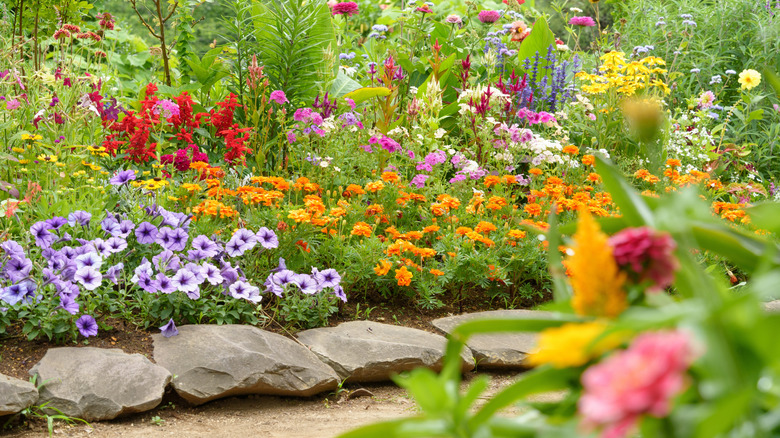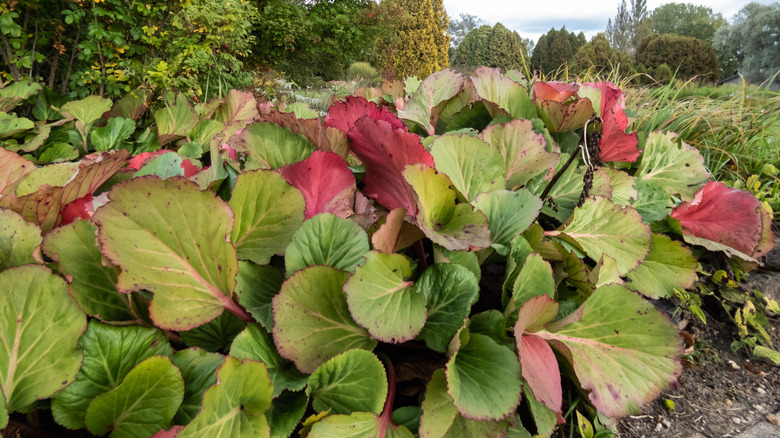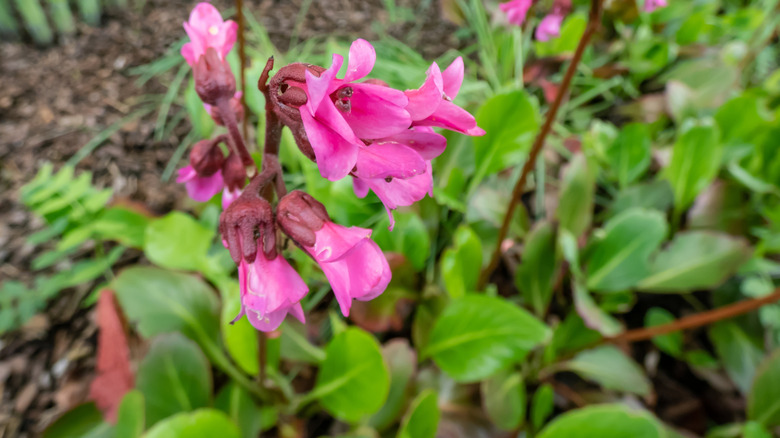The Purple Flower You Can Plant In Early Spring To Help Prevent Weeds Later
A surefire way to become a millionaire: invent an easy way to get rid of weeds in your garden without harming other plants or wildlife. In the meantime, nature already has the closest thing to that invention, and it's called purple bergenia (Bergenia purpurascens). This flowering plant naturally suppresses weeds while attracting beneficial pollinators, and spring is the ideal time to plant it.
Purple bergenia is an herbaceous perennial native to Asia. At an average height of 1 to 1 1/2 feet, it's compact enough to be grown as a ground cover or border. And because its foliage is dense and thick, it blocks weed seeds in the soil from receiving any sunlight, which prevents them from even germinating, let alone breaching the surface. This foliage is also evergreen, providing year-round weed suppression.
Planting purple bergenia provides a similar effect as laying mulch or a tarp over your garden beds to keep weeds from emerging. But by using a ground cover as a weed suppressant instead, you'll save time and effort in the long run since you don't have to fill gaps or replace materials year after year. Purple bergenia is a low-maintenance, versatile plant that provides additional perks aside from weed control.
How to plant Bergenia purpurascens for weed control
Not only does Bergenia purpurascens prevent weeds from growing, it also keeps soil from eroding and improves biodiversity by providing food to pollinators like bees and butterflies. It also has visual interest: its thick, glossy leaves turn a rich red in the fall, and the clusters of spring flowers range from pink to purple to purplish-red.
Purple bergenia is also highly adaptable. It can grow in partial sun to full shade and in poor or rich soil, though it prefers well-draining soil that is rich in humus. Plant it in spring as soon as frost is no longer a threat in your area. This timing allows purple bergenia to adjust to its new environment and grow strong roots before the heat of summer.
To plant purple bergenia, dig a hole twice the width and the same depth as the root ball. Add amendments to the soil if needed, then place the plant and backfill the hole with soil before watering thoroughly. Space each plant 1 to 3 feet apart to allow for growth. You can also grow bergenia from seed, but you would need to start it indoors six to eight weeks before the last spring frost, as it takes up to six weeks for bergenia seeds to germinate.
How to care for purple bergenia
Purple bergenia is cold-hardy in USDA zones 4 to 8. It's drought-tolerant once established, but it's best to keep the soil evenly moist. Add mulch to retain moisture in hotter climates. In early spring, prune the broken or dead bits.
Other than that, this plant requires little upkeep. If the soil is rich in nutrients, there's no need to add extra fertilizer, and it's resistant to deer and rabbit damage. Some weed-suppressing plants can become nuisances themselves, but not purple bergenia, which is a slow spreader and not particularly weedy or aggressive.
Other ground covers that prevent weeds from taking over and are easy to control include creeping thyme, elfin thyme, and Irish moss. And if you're interested in bergenias with different blooming times or flower colors, explore other species and hybrids, like Bergenia cordifolia and Bergenia crassifolia.


